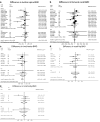Associations of APOE gene polymorphisms with bone mineral density and fracture risk: a meta-analysis
- PMID: 20533025
- PMCID: PMC3144470
- DOI: 10.1007/s00198-010-1311-5
Associations of APOE gene polymorphisms with bone mineral density and fracture risk: a meta-analysis
Abstract
To determine the association of the Apolipoprotein E (APOE) E4 gene polymorphism with bone mineral density (BMD) and fractures we conducted a meta-analysis of 17 reports. Despite lower trochanteric and lumbar BMD in APOE4 carriers, there is insufficient evidence to support a consistent association of APOE with bone health.
Introduction: APOE has been studied for its potential role in osteoporosis risk. It is hypothesized that genetic variation at APOE locus, known as E2, E3, and E4, may modulate BMD through its effects on lipoproteins and vitamin K transport. The purpose of this study was to determine the association of the APOE-E4 gene polymorphism with bone-related phenotypes.
Methods: We conducted a meta-analysis that combined newly analyzed individual data from two community-based cohorts, the Framingham Offspring Study (N = 1,495) and the vitamin K clinical trial (N = 377), with 15 other eligible published reports. Bone phenotypes included BMD measurements of the hip (total hip and trochanteric and femoral neck sites) and lumbar spine (from the L2 to L4 vertebrae) and prevalence or incidence of vertebral, hip, and other fractures.
Results: In sex-pooled analyses, APOE4 carriers had a 0.018 g/cm(2) lower weighted mean trochanteric BMD than non carriers (p = 0.0002) with no evidence for between-study heterogeneity. A significant association was also detected with lumbar spine BMD (p = 0.006); however, inter-study heterogeneity was observed. Associations with lumbar spine and trochanteric BMD were observed predominantly in women and became less significant in meta-regression (p = 0.055 and 0.01, respectively). There were no consistent associations of APOE4 genotype with BMD at other skeletal sites or with fracture risk.
Conclusions: Based on these findings, there is insufficient evidence to support a strong and consistent association of the APOE genotype with BMD and fracture incidence.
Conflict of interest statement
All authors have no conflict of interest. They have full control of all primary data and agree to allow the journal to review their data if requested.
Figures


Similar articles
-
ApoE gene polymorphisms, BMD, and fracture risk in elderly men and women: the Rotterdam study.J Bone Miner Res. 2004 Sep;19(9):1490-6. doi: 10.1359/JBMR.040605. Epub 2004 Jun 21. J Bone Miner Res. 2004. PMID: 15312249
-
A common polymorphism rs1800247 in osteocalcin gene was associated with serum osteocalcin levels, bone mineral density, and fracture: the Shanghai Changfeng Study.Osteoporos Int. 2016 Feb;27(2):769-79. doi: 10.1007/s00198-015-3244-5. Epub 2015 Jul 21. Osteoporos Int. 2016. PMID: 26194493
-
Association of P2X7 receptor polymorphisms with bone mineral density and osteoporosis risk in a cohort of Dutch fracture patients.Osteoporos Int. 2013 Apr;24(4):1235-46. doi: 10.1007/s00198-012-2059-x. Epub 2012 Jul 10. Osteoporos Int. 2013. PMID: 22776862 Free PMC article.
-
Bone mineral density at femoral neck and lumbar spine in adults with type 1 diabetes: a meta-analysis and review of the literature.Osteoporos Int. 2017 Sep;28(9):2601-2610. doi: 10.1007/s00198-017-4097-x. Epub 2017 Jun 3. Osteoporos Int. 2017. PMID: 28580510 Review.
-
Change in Bone Density and Reduction in Fracture Risk: A Meta-Regression of Published Trials.J Bone Miner Res. 2019 Apr;34(4):632-642. doi: 10.1002/jbmr.3641. Epub 2019 Jan 23. J Bone Miner Res. 2019. PMID: 30674078
Cited by
-
The Contribution of Lipids to the Interindividual Response of Vitamin K Biomarkers to Vitamin K Supplementation.Mol Nutr Food Res. 2019 Dec;63(24):e1900399. doi: 10.1002/mnfr.201900399. Epub 2019 Oct 3. Mol Nutr Food Res. 2019. PMID: 31533195 Free PMC article. Clinical Trial.
-
Lower-Body Fractures and the Risk of Dementia: A Nationwide Population-Based Study.J Clin Neurol. 2024 Mar;20(2):208-213. doi: 10.3988/jcn.2022.0257. Epub 2024 Jan 1. J Clin Neurol. 2024. PMID: 38171503 Free PMC article.
-
Potential Biological and Genetic Links Between Dementia and Osteoporosis: A Scoping Review.Geriatrics (Basel). 2025 Jul 20;10(4):96. doi: 10.3390/geriatrics10040096. Geriatrics (Basel). 2025. PMID: 40700291 Free PMC article. Review.
-
Modulation of Bone Mineral Density and Its Response to Menopausal Hormone Therapy according to the Apolipoprotein E Genotype in Postmenopausal Korean Women.J Menopausal Med. 2024 Apr;30(1):37-43. doi: 10.6118/jmm.23033. J Menopausal Med. 2024. PMID: 38714492 Free PMC article.
-
Sirt1 is involved in decreased bone formation in aged apolipoprotein E-deficient mice.Acta Pharmacol Sin. 2015 Dec;36(12):1487-96. doi: 10.1038/aps.2015.95. Epub 2015 Nov 23. Acta Pharmacol Sin. 2015. PMID: 26592520 Free PMC article.
References
-
- Eichner JE, Dunn ST, Perveen G, Thompson DM, Stewart KE, Stroehla BC. Apolipoprotein E polymorphism and cardiovascular disease: a HuGE review. Am J Epidemiol. 2002;155:487–95. - PubMed
-
- Schilling AF, Schinke T, Munch C, Gebauer M, Niemeier A, Priemel M, Streichert T, Rueger JM, Amling M. Increased bone formation in mice lacking apolipoprotein E. J Bone Miner Res. 2005;20:274–82. - PubMed
-
- Long JR, Liu PY, Liu YJ, Lu Y, Shen H, Zhao LJ, Xiong DH, Deng HW. APOE haplotypes influence bone mineral density in Caucasian males but not females. Calcif Tissue Int. 2004;75:299–304. - PubMed
-
- Shiraki M, Shiraki Y, Aoki C, Hosoi T, Inoue S, Kaneki M, Ouchi Y. Association of bone mineral density with apolipoprotein E phenotype. J Bone Miner Res. 1997;12:1438–45. - PubMed
-
- Johnston JM, Cauley JA, Ganguli M. APOE 4 and hip fracture risk in a community-based study of older adults. J Am Geriatr Soc. 1999;47:1342–5. - PubMed
Publication types
MeSH terms
Substances
Grants and funding
LinkOut - more resources
Full Text Sources
Medical
Miscellaneous

